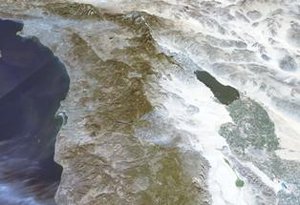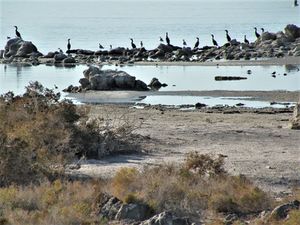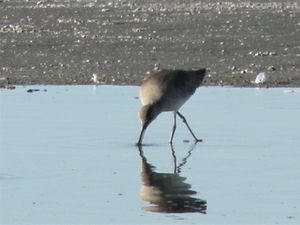Salton Sea, California
Contents
Hydrological History
The Salton Basin, once connected to the Gulf of California, is characterized by a shallow marine environment. For the past several million years, sediments that once filled the Grand Canyon were eroded by the Colorado River and deposited in the Gulf of California, eventually creating a large delta, blocking off the Salton Basin from the ocean. Once separated from the Gulf of California, the Salton Basin would periodically dry out as the Colorado River drained directly into the Gulf of California. At other times, the river would change course and fill the basin. These prehistoric inundations have been called Lake Cahuilla or alternatively Lake LeConte.
The present-day Salton Sea was formed in the year 1905 when flood flows on the Colorado River rushed into the Salton Basin (Salton Sink) through a temporary diversion channel until the breach was finally filled by the Southern Pacific Railroad Company in 1907. After an initial high stand of about -195 ft msl, the sea receded to an elevation about -250 ft msl by the year 1920. Since that time, with the expansion of agriculture in the Imperial and Coachella valleys and increased agricultural run-off, the surface elevation of the sea has risen to its current elevation of about -227 ft msl. The elevation of the sea has remained relatively stable at its current level since the 1980s, indicating that the inflow of about 1.34 Maf is equal to evaporation at that elevation.
Fauna
Water Quality
Approximately 4.5 million tons of salts are added to the sea annually. Because evaporation is the only outlet from the sea, the dissolved salts, nutrients, and minerals that enter the sea remain there, and have accumulated over the past century to the point at which the sea is now about 25% saltier than the ocean, at about 44,000 mg L. Increasing salinity may cause the fishery to collapse as it approaches 60,000 mg L. At the present rate of salt loading of about 4.5 million tons per year, the Salton Sea would reach the 60,000 mg L threshold in about one half century, assuming inflow remains at its present level of 1.34 Maf per year.
Nutrient loading from agricultural run-off has created eutrophic conditions at the Salton Sea. Productivity and biomass are very high, leading to oxygen depletion caused by decay of accumulated biological material. These anoxic conditions have contributed to extensive fish kills over the past few decades, leading to further oxygen depletion. Eutrophic conditions worsen during summer months, when high biological productivity and warm water temperatures conspire to greatly reduce dissolved oxygen throughout the water column. One event, in August 1999, resulted in the death of six to seven million fish over a period of several days. Chemical data taken at the time indicated an almost complete loss of dissolved oxygen in portions of the sea coincident with that event.
Conservation Outlook
With reduced inflows from water transfers, conservation measures and increased demand, salinity increases rapidly and the contracting lake concentrates salts already in residence while more salts continue to enter the sea in agricultural run-off. With a reduction of inflow by 300,000 af per year, salinity would reach the 60,000 mg L threshold for the fishery in about twelve years; and with a reduction of 500,000 af, salinity would reach the limit of tolerance of the fishery in just merely five years. The collapse of the fishery would represent a serious adverse environmental impact. The death of 200 million fish would have a cascade effect on the rest of the ecosystem, causing the demise of many fish-eating bird populations, exacerbating eutrophication from decomposition of the dead fish, and creating a huge breeding ground for flies and other pathogens in their rotting carcasses. Many species of birds would be critically impacted. Ground-nesting bird colonies on Mullet Island-the only island in the sea-would be exposed to coyotes, cats, and other predators with a draw down of merely seven feet. Many other species would experience substantial whole-species population declines. Other potential impacts of reduced inflows to the Salton Sea include collapse of lake-related economies, such as boating, hunting, fishing, and property values; degradation of air quality as a result of exposure of as much as 120 mix2 of fine lake bottom sediments to the desert winds; loss of agricultural productivity from salt and dust deposition; and increased respiratory disease and human health problems as a result of airborne sediments.
References and Further Reading
- Hely, A.G.; Hughes, G.H.; Irelan, B. Hydrologic Regimen of the Salton Sea; Professional Paper 486-C, U.S. Geologic Survey: Washington, 1966; 1-32.
- Downs, T.; Woodward, G. Middle Pleistocene Extension of the Gulf of California into the Imperial Valley. Geol. Soc. Am. Special Paper 1961, 68 (21).
- Dibblee, T. W., Jr. Geology of the Imperial Valley Region, California. In Geology of Southern California, California Division of Mines and Geol. Bull.; Jahns, R.H., Ed.; State of California: San Francisco, 1954; Vol. 170, 21-28.
- Laflin, P., 1995. The Salton Sea: California's overlooked treasure. The Periscope, Coachella Valley Historical Society, Indio, California. 61 pp. (Reprinted in 1999)
- Krantz, T.; Buckles, J.; Kashiwase, K. Reconstruction of Prehistoric Lake Cahuilla and Early American Settlement Patterns in Southeast California Using GIS. Proceedings of the Twentieth Annual ESRI International User Conference, San Diego, California, 2000.
- Waters, M.R. Holocene Lacustrine Chronology and Archaeology of Ancient Lake Cahuilla. Calif. Quat. Res. 1983, 19, 373-387.
- Wilke, J.P. Late Prehistoric Human Ecology at Lake Cahuilla, Coachella Valley, California. Contr. of the Univ. of Calif. Arch. Res. Facility, Berkeley, 1978, 38.
- Schaefer, J. An Inventory and Evaluation of Lake Cahuilla Cultural Resources Along Imperial Irrigation District's SA- Line, San Diego and Imperial Counties, California. Prepared by ASM Affiliates, Inc., Encinitas, California, December 2000.
- Salton Sea Authority, U.S. Bureau of Reclamation. Draft Salton Sea Restoration Project Environmental Impact Statement/Environmental Impact Report. Prepared by Tetra Tech, Inc., January, 2000.
- Hurlbert, S.; Dexter, D.; Kuperman, B. Reconnaissance of the Biological Limnology of the Salton Sea. Prepared for the Salton Sea Authority, 1998.
- Reidel, R.; Helvenston, L.; Costa-Pierce, B. Final Report: Fish Biology and Fisheries Ecology of the Salton Sea. prepared Under Contract to the Salton Sea Science Office, 2001.
- Shuford, W.D.; Warnock, N.; Molina, K.C.; Mulrooney, B.; Black, A.E. Avifauna of the Salton Sea: Abundance, Distri¬bution, and Annual Phenology. Contribution No. 931 of Point Reyes Bird Observatory. Final Report for EPA Con¬tract No. R826552-01-0 to the Salton Sea Authority, 2000.
- Thiery, R. The Potential Impact of Rising Salinity on the Salton Sea Ecosystem. Prepared Under Contract to the Salton Sea Science Office, 1998.
- Setmire, J.; Holdren, C.; Robertson, D.; Amrhein, C.; Elder, J.; Schroeder, R.; Schladow, G.; McKellar, H.; Gersberg, R. Eutrophic Conditions at the Salton Sea. A Topical Paper from the Eutrophication Workshop Convened at the University of California at Riverside, Sept 7-8, 2000. Prepared for the Salton Sea Authority, the Salton Sea Science Office, and the Bureau of Reclamation, 2000.
- Holdren, C. Chemical and Physical Analysis of the Salton Sea. Prepared for the Salton Sea Authority, U.S. Bureau of Reclamation, Denver, Colorado, 2000.
- Imperial Irrigation District, U.S. Bureau of Reclamation. Draft Environmental Impact Report/Environ¬mental Impact Statement Imperial Irrigation District Water Conservation and Transfer Project and Draft Habitat Conservation Plan. Prepared by CH2MHILL, 2002


